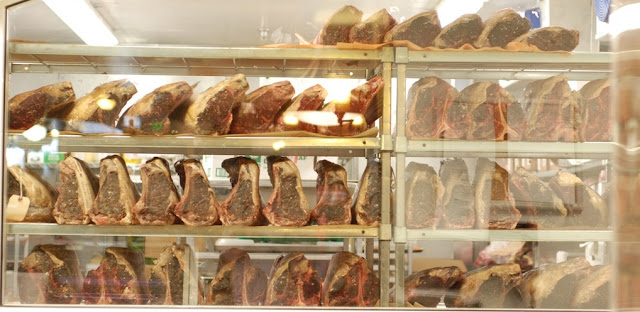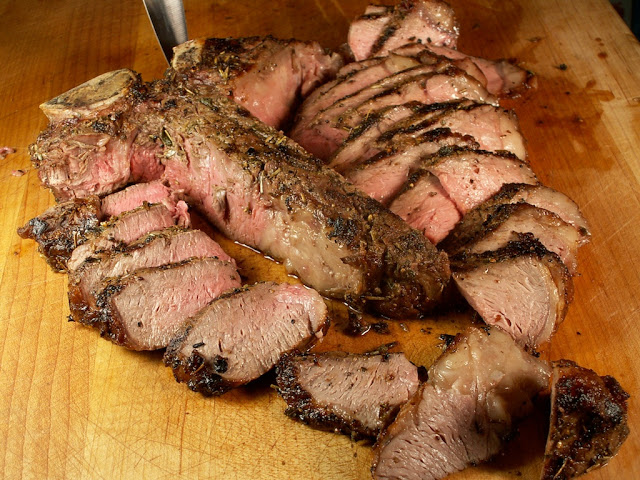Posted on: April 19th, 2012
Dry aged meat is a time-honored butchery practice, and something Tony has always insisted on. Sides or quarters are hung in ideal conditions for two, four or even six weeks, making them much more tender and flavorful. The animal’s natural enzymes and evaporation are the agents of change.

Short Loins Dry Aging in our cooler for the ultimate T-bone Steaks
Dry Aged Meat
30 years ago, any self-respecting butcher would dry age his beef as long as he could afford to, but things have changed. Back in the day, my brother DJ and I would lug 150-pound quarters of beef off a truck, up the stairs and into the aging cooler (and we still have the back pain to prove it). Today most beef is reduced to steak-ready cuts, cryovaced in an oxygen free package and shipped in boxes (and subsequently butchery skills are at an all time low).

Breaking Beef at Tony’s Dry Creek Market in the 1980’s
Wet Aging
Meats in cryovac do age, but the results are very different from Dry Aging. Wet aging does increase tenderness, which peaks at about 4 weeks, but flavors do not improve. Wet aging lowers costs because there is no shrinkage, less cutting loss, less trimmings, and it’s faster and easier to cut (sadly few butchers know how to do more than slice steaks anymore).
Dry Aging
Dry Aging meat involves larger cuts, such as quarters and on the bone primals. Under ideal conditions (38-40° with good air circulation and no meat touching), Dry Aged meats not only get more tender, but their flavor matures and improves dramatically.
With dry aging comes shrinkage, expect losses from 20-30% depending on the cut and aging time. The entire outer surface dries out and turns black and must be trimmed and thrown away, and there is a great deal of evaporation – which means steaks with a lower water content – a big advantage when cooking!

Loins, Ribs and Strips Dry Aging in our old Market at 950 Broadway
Lower Water Content Means Better Steak
Grills are a great way to cook steaks because the water released drips away and evaporates quickly; in the pan or at low heat, steaks steam and simmer in their liquid. Moist heat is great for pot roasts, but NOT steaks! Dry aged steaks have a much lower water content, so they naturally cook up better, have a richer flavor, and a better texture – especially when grilled.

High searing heat on a grill quickly evaporates moisture for the best texture and flavor.
Beef Grade and Aging
It’s important to start with high-grade beef, the higher the grade, the more aging will improve the flavor and tenderness. We always age our Premium Choice and Prime beefsteaks for 21-28 days, through experimenting we’ve found that aging high grade beef makes a big difference, but not so much so on low grade beef. My guess is the potential for high grade beef to be great is much greater, I believe due to the marbling.

CEO Daniel Rosacci and Broadway Store Director Stuart Stevenson inspecting beef.
Tony’s Aging Program
We employ both wet and dry aging techniques in our markets.
Wet Aged Steaks:
We always have a great supply of wet aged Premium Choice steaks in our markets – aged for 3-4 weeks, they offer great taste and tenderness at the best price possible.
Dry Aged Steaks:
We also offer Dry Aged NY Strips, Ribeyes, and T Bones. Depending on the time of year, most of our markets have them cut and in the case every weekend. If you don’t see them, just ask! Our butchers are always more than happy to cut some for you.
Custom Aged and Cut Beef
I suggest buying a whole primal cut (a whole loin or rib) and let us custom age it for you. We can age it as long as you like, and then we’ll custom cut and wrap it to order. This is a great way to prep for a special event or stock your freezer and save a few bucks at the same time.

A T-bone Steak, dissected, NY Strip on the right side, Tenderloin on the left, and plenty of meat left on the bone for gnawing!
About the author: Chef Mick (Michaelangelo) Rosacci is the Corporate Chef and co-owner of Tony’s Markets in the Denver Metro area. Mick teaches cooking on Dig In Colorado, a local gardening and cooking show on FOX. He also taught cooking on Denver’s Channel 7 News for 12 years and was wrote a food column for the Colorado Community News for 11 years. For more recipes and our very best deals, join Tony’s Rewards.
Leave a Reply







